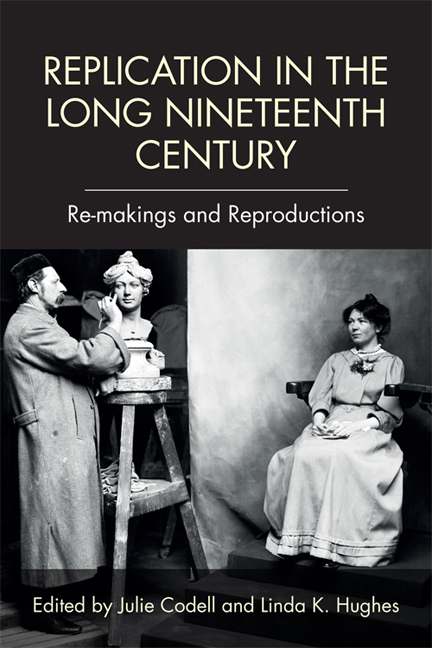Book contents
- Frontmatter
- Contents
- List of Illustrations
- Acknowledgments
- 1 Introduction: Replication in the Long Nineteenth Century – Re-makings and Reproductions
- I Replication and Networks
- II Replication and Technology
- 6 Replicating Tennyson's The Princess, 1847–1853
- 7 Paisley / Kashmir: Mapping the Imitation-Indian Shawl
- 8 William Morris and the Form and Politics of Replication
- 9 Text and Media Replication During the U.S.–Mexican War, 1846–1848
- III Replication and Authenticity
- IV Replication and Time
- Notes on Contributors
- Index
8 - William Morris and the Form and Politics of Replication
from II - Replication and Technology
Published online by Cambridge University Press: 11 August 2018
- Frontmatter
- Contents
- List of Illustrations
- Acknowledgments
- 1 Introduction: Replication in the Long Nineteenth Century – Re-makings and Reproductions
- I Replication and Networks
- II Replication and Technology
- 6 Replicating Tennyson's The Princess, 1847–1853
- 7 Paisley / Kashmir: Mapping the Imitation-Indian Shawl
- 8 William Morris and the Form and Politics of Replication
- 9 Text and Media Replication During the U.S.–Mexican War, 1846–1848
- III Replication and Authenticity
- IV Replication and Time
- Notes on Contributors
- Index
Summary
Replication is a key feature across William Morris's work and thought in the decorative arts and the art of the book. Patterns of rhythmic, repeating structures, mostly botanical in form, populate the surfaces of his designs, and while Morris and his subsequent critics have frequently discussed the affective quality of this formal emphasis on replication, there has been less discussion of its politics. In Morris's 1888 essay “Textiles,” he invites his readers to
go to the South Kensington Museum and study the invaluable fragments of the stuffs of the 13th and 14th centuries of Syrian and Sicilian manufacture, or the almost equally beautiful webs of Persian design, which are later in date, but instinct with the purest and best Eastern feeling.
(1888b: 1134)What kind of “feeling” was woven into these centuries-old textile patterns? Morris describes it as a pleasing sense of geometrical fitness that comes from reflection upon a well-conceived structure: “it is just this logical sequence of form, this growth which looks as if, under the circumstances, it could not have been otherwise, which prevents the eye wearying of the repetition of the pattern” (1135). Elsewhere, in an 1884 essay titled “Textile Fabrics,” he similarly explains the affective appeal of such patterns in terms of the agreeable contemplation of sound structure: “the beauty of the drawing and the ingenuity of the pattern combined give us that satisfying sense of ease and mystery which does not force us to keep following for ever the repetition of the pattern” (45). Critics and admirers of Morris's work today continue to express such feelings about the patterns that Morris himself designed. A. S. Byatt, for example, in her 2016 volume Peacock … Vine: On William Morris and Mariano Fortuny, describes the specific kind of enjoyment found in the contemplation of Morris's patterns Honeysuckle (fabric, 1876; see Figure 8.1) and Willow Bough (wallpaper, 1887):
I remember being overcome with delight when I first realised how rigorously the geometry of plants worked among the apparently accidental forms of particular flowers or leaves. T here are plants which grow according to the Fibonacci spiral – 1, 1, 2, 3, 5, 8, etc. – which always seemed to me a peculiarly human construction – each number being the sum of the previous two numbers – and not a growth pattern at all.
- Type
- Chapter
- Information
- Replication in the Long Nineteenth CenturyRe-makings and Reproductions, pp. 144 - 161Publisher: Edinburgh University PressPrint publication year: 2017

